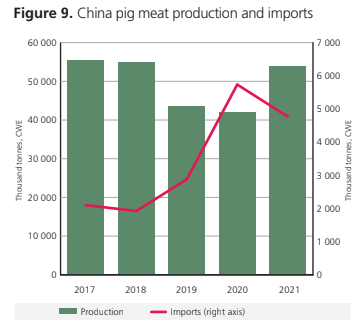



FAO Meat Market Review: Pig meat
Growth in the pig meat trade slowed down due to production recovery in ChinaEditor's note: The following is a portion of the July 2022 FAO Meat Market Review publication summarizing the salient trends and drivers of the global meat market developments in 2021.
Global pig meat output reached 122.5 million tonnes, up 11.5 percent from 2020, driven principally by a sharp output expansion in Asia, some increases in Europe and South America, offset by a significant downturn in North America. The 28 percent increase in China’s pig meat output, equivalent to 11.8 million tonnes, to around 54 million tonnes, underpinned the global output expansion, overshadowing some not-so-insignificant gains in Brazil, the European Union, Viet Nam and the Russian Federation.
The sharp increase in output in China ended three consecutive contractions since 2018 following the ASF outbreak. Production is only slightly behind the pre-ASF output level with the latest expansion. Increased slaughter in anticipation of price falls from mid-2021 principally underpinned production expansion.

Brazil’s pig meat output expanded on robust internal and external demand. Following a 2.9 percent fall in 2020, the European Union pig meat production rose by 1.7 percent to 23.6 million tonnes, driven by expansions in some member states such as Spain, which remained free from ASF outbreaks. Although ASF outbreaks continued unabated in Viet Nam, pig meat output increased slightly since mid-2020. In the Russian Federation, output expanded slowly compared to 2020, mainly led by large-scale farms. Still, the growth rate fell as businesses adjusted their production plans to face the ASF epidemic.
By contrast, pig meat output fell in the Philippines and the United States. In the Philippines, ASF outbreaks continued in regions with widespread pig farming, lowering pig slaughter levels and plunging pig meat production by nearly 21 percent. Pig meat production dropped to 12.6 million tonnes in the United States, a 2.2 percent lower compared to 2020, amid the continued decline in hog stocks.
Global pig meat trade stood at 12.7 million tonnes in 2021, down 2.1 percent from 2020, caused by import contractions in Asia and Europe, although imports of all other regions increased.
China registered the sharpest import curtailment at the country level, with some declines in the United Kingdom, the European Union, and Canada. In China, domestic availability of pig meat increased, stemming from the faster-than-expected recovery of hog stocks and the decline in domestic pig meat prices, slowing down import demand in the second half of the year. Increased production and moderate to muted growth in the internal market enabled the United Kingdom, the European Union, and Canada to curtail imports.
By contrast, the Philippines, Mexico and the United States increased pig meat imports in 2021. In the Philippines, the Minimum Access Volume allocation and lowering tariff rates helped increase imports. In Mexico, purchases rose due to inadequate production growth to fulfil growing demand from the food processing industry and consumers.
The United States imported more pig meat, mainly from Canada, driven by the market tightening due to the decline in domestic pig meat output. Viet Nam registered an increase in imports as well, though slightly, reflecting the ASF-induced supply gap.
Concerning exports, several large exporters shipped less pig meat, especially the European Union, the United Kingdom, the United States and Canada, as they faced weak demand from their regular buyers, especially China.
Besides lower import purchases, pig meat producers in the European Union and the United States lowered farrowing on increased feed costs, causing overall supplies to fall. Despite these challenges, the European Union and the United States exported 5.2 million tonnes and 3 million tonnes, respectively. Reflecting the depressed global demand, exports from Chile, Mexico, Thailand and Argentina also fell.
To read the full report, click here.
Reference: FAO. 2022. Meat Market Review 2021. Rome.








